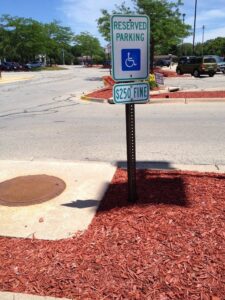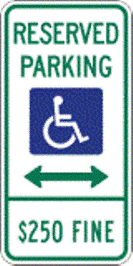
Handicapped Accessibility has been mandated in our society since 1990 when the Americans with Disabilities Act (ADA) was signed into law. For many of us, it has no direct bearing on our lives, and we don’t give much thought to exactly what it means to be “accessible”. If you are a business owner who serves the public, this law has more of an impact on you than you may realize.
Unfortunately, a lot of confusion surrounds the subject due to the numerous entities making the rules. This article should clear up some confusion. The system is set up as a bottom-up hierarchy.
1) The Federal Government lays down the foundation (The ADA). It’s from this central document that other Federal Codes are developed (i.e.: building codes).
2) The next level is the state: Each state is permitted to modify the underlying document, but only if they are MORE stringent than the federal guidelines. Otherwise the underlying laws take precedence.
3) The same is true for the next tier – the local level. Local ordinances can only be more stringent than the 2 underlying levels of law, otherwise the strongest language prevails.
Prioritizing is the Key
The US Department of Justice (DOJ) has defined an order of “Priorities” for Public Accommodations for bringing their facilities and sites into compliance with accessibility requirements. The Priorities are:
1 – Get people to your building;
2 – Get people into your building and provide basic services;
3 – Provide barrier-free toilet rooms.
4 – Provide full barrier-free access to all public use aspects of the facility.
Illinois Parking Requirements
Parking lot signage is ubiquitous – most of us generally don’t notice them, let alone what they say, or whether or not they even exist. The State of Illinois has specific signage requirements for Handicapped Parking stalls. The state of Illinois as well as many others, require a violation sign to be installed, displaying the current fine amount for illegal parking in Handicapped stalls. In Illinois, this value was originally set at $50. It was updated in 1996 to $100; and again in 2006 to a minimum of $250 (with a maximum of $350 by local ordinance).

Debunking the Misconceptions – Things That I’ve Been Told:
Myth: I am a private business – I don’t have to comply with these regulations.
FALSE: Any business offering goods and services to the public is defined by the DOJ as a Public Accommodation, and must adhere to Accessibility Codes.
Myth: My facility is “grandfathered” in because it pre-dates any accessibility code.
FALSE: Removal of barriers is a requirement of all businesses. The DOJ’s Code of Federal Regulations states the following: A public accommodation shall remove architectural barriers in existing facilities….where such removal is readily achievable, i.e. easily accomplishable and able to be carried out without much difficulty or expense. The section defines 21 examples of readily achievable updates, including “creating designated accessible parking spaces”.
Myth: I haven’t remodeled my building or done anything to the parking lot. The Illinois Accessibility Code says that I only need to worry about accessibility if I remodel.
FALSE: This goes back to our hierarchy– the federal ruling is that barrier removal is required of ALL public accommodations, and a state can’t reduce the federal requirements.
Myth: I don’t need a handicapped parking sign because I have the symbol painted on the ground.
FALSE: Illinois requires that all handicapped parking stalls be demarcated with both the striping and symbol on the ground and the sign in front of the stall.
Myth: It doesn’t matter what the signs look like or where they are – as long as I have something then I’m covered.
FALSE: The state has mandated a specific sign design, mounting height and placement.
Accessibility Means Business
Our population is aging. The first wave of baby boomers turned 65 in 2011 and our population is also living longer. If your parking doesn’t currently comply with state requirements, where will the continually increasing number of patrons with disabilities park? Keep in mind: the segment of population with the most discretionary funds are those who are 65 and over. If they can’t get into your building, they will go someplace where they can.
Federal Tax Credits Available:
Check with the federal government when it comes to receiving federal tax credits which may be available to help offset costs for facilities attempting to upgrade to comply with new ADA regulations.
Sources:
- Disability and Business Technical Assistance Center (DBTAC) – Great Lakes: http://www.adagreatlakes.org/
- Illinois Attorney General’s Office – : http://www.illinoisattorneygeneral.gov/rights/accessible_parking.html
- Illinois Handicapped Parking Requirements Brochure: http://www.illinoisattorneygeneral.gov/consumers/brochures/accesspkg_brochure.pdf
- Definition for ADA – TITLE III: http://www.workworld.org/wwwebhelp/americans_with_disabilities_act_ada_.htm#Americans_with_Disabilities_Act_ADA_Title_III
- United States Access Board: http://www.access-board.gov/
- City of Chicago Mayor’s Office for People with Disabilities: https://www.chicago.gov/city/en/depts/mopd/provdrs/resource.html
- RAMP: http://rampcil.org/index.asp
